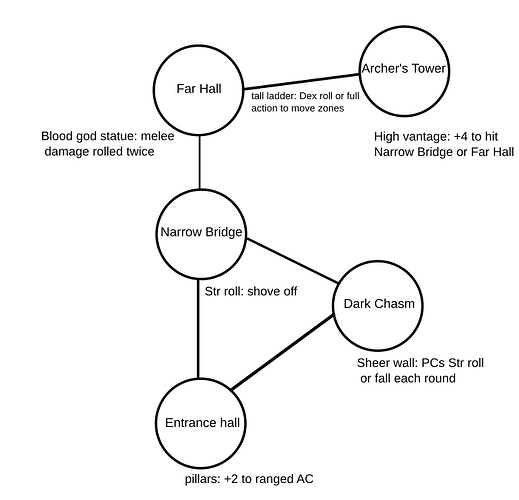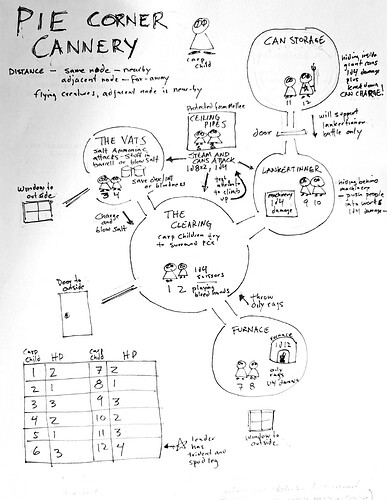On your point about Everything is happening in two dimensions, I advocate for a point-crawl structure: its quick to sketch on the fly, it boils the geography down to the essential details (what links to what) without overwhelming everyone, and it allows for some tactical complexity to build up.
For example, lets take something you might have written off as too complex for theatre of mind in your blog: The PCs face off against a half-dragon cult leader, his four kobold guards (two with bows) and their spider swarm pets.
I would sketch out something like the below for my players:
and say something like:
“As you emerge into the pillared entrance hall you see the cultist on the far side of a narrow bridge before a towering statue of his insane god. Two kobolds with spears and pilfered mail block the bridge, while two more lurk in the shadows above him atop a rickety tower. From the dark chasm underneath the bridge the rustling and chittering of sharp mandibles can be heard, and they are growing louder”
I think this does a good job of conveying the fiction and avoiding nasty player surprises (“can we push forward two abreast down the bridge? Oh wait never mind, I guess not if its narrow, huh?”)
and in a context of ‘rulings not rules’ you have lots of fodder to generate new options as you need (“is there really no way down from the archer’s tower to the bridge? What if I tie my rope and swing down?” “…I’ll allow it, make a dex roll.”)
This setup breaks your rules 1,2, 4 and 5 in fact, and we could easily add in a blood-slick floor to the Far Hall to break rule 3 too. Do you still think it would be boring/hard/uninteresting to run a combat this way? Genuine question ![]()
Just to be clear, I did not write the post!
Oh, aha! well thanks for sharing
OH, this is excellent.
I am currently working on a THING where I half implemented this idea. But instead of a point crawl diagram, I used a real map. But the idea was that it was a large combat against many foes, so I stuck them all in little pockets of the map, put some walls in here and there, just to break up the fight into smaller chunks-- so that each chunk could have its due. (some enemies hiding in the ceiling in this part, some hiding behind barrels here, some out in the open luring you in over there, etc)
However, I think a diagram is superior, because it keeps the focus on the abstraction, and likely to more easily get info in there to keep things dynamic.
once you introduce real space, it starts the DM brain going, I AM GOING TO WHITEBOARD THIS. whereas a diagram will be more of a reminder of how to explain it to people to keep it IN THE MIND. which I kinda prefer. ultimately, I think introducing a battlemap is more limiting than engaging. it establishes bounds, and makes people think more 2 dimensionally, both literally and figuratively.
Gonna reskin it today (and maybe post it all if it is in good shape).
My gold standard for TotM combat is Fabula Ultima. Positioning is much less of a concern there than managing status effects, resources, and elemental affinities
I think this is actually easier to run even though this diagram looks f****** insane. I mean it’s just a draft I would clean it up and make it legible to someone who can’t read my handwriting… AKA everyone else in the world. What would be accompanying this is longer descriptions of the nodes in the text.
And this would be replacing a traditional dungeon map with just room number keys.
Your point crawl structure reminds me of how Zones are used in Fate. I think it works really well as a tool for theater of the mind combat and can be easily tweaked or adapted to different systems.
On the substack post I left my comment which I report here if anyone wants to discuss it further.
If I understood correctly the problem of ‘flatness’ is referred to the fact that everything is clear as a drone is showing a 360° view of the scene from the top. The ‘flatness’ effect in TofM action to my eyes is due to the way of mastering the action, it is not referred to the situation itself and in that sense there are some tricks a GM can adopt to ‘deflatten’ it:
Needless to say, pls correct me if I misunderstood the problem.

